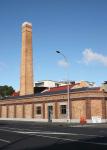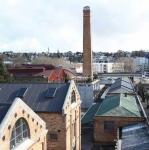The Iconic Victoria Street Market Redevelopment. A Work In Progress
Back in the 1980s Victoria Park Market was a popular destination for tourists and locals alike with its landmark chimney, colourful shops, stalls and
restaurants.
It was a vibrant part of the city, particularly as weekend shopping was quite limited back in those days.
Over the years though, the crowds subsided as the precinct became increasingly rundown and tenants departed for greener pastures. However, a $20 million
redevelopment by consortium Victoria Quarter Trust that is halfway complete is bringing the buzz back to the markets. Already, new shops, restaurants
and bars have opened in the market, while work continues elsewhere.
CMP Construction is the main contractor on the redevelopment which will see 80 new shops, restaurants and bars as well as office space at Victoria Park Market, housed in either restored heritage buildings or the two new two-storey concrete pre-cast buildings that are situated between the Depot
Buildings that front Victoria St and the Generator Room, Boiler Room and Battery Building on Drake St. There is also an extension to the battery building and a new building in the western courtyard. The new-look markets will also have a stage for live performances and a giant TV screen.
The overall redevelopment has been designed by Clark Brown Architects with the restoration of the original buildings overseen by Dave Pearson Architects, specialists in heritage conservation.
Tony Howard, of CMP, says being able to create more retail space and attract more tenants offsets the costs involved with restoration.
“What we’ve done is a compromise with the council where we’ve kept and restored the old buildings but to make that feasible we’ve built some big new ones inside the precinct,” says Tony.
Restoring the landmark 38m-tall chimney cost $600,000 alone, he says, and involved workers abseiling down inside the chimney to remove tonnes of bricks because the inside layer of the chimney had collapsed. Once that dirty, laborious job had been completed, the chimney was reinforced by spraying the inside with a layer of Flexus Shotbond, which helps make the structure stronger while still being flexible. The chimney is not only the symbol of Victoria Park Markets but also a reminder of its past. It and the adjacent Destructor were built in 1905 to deal with Auckland’s growing rubbish problem when city
officials became worried about the disease risk posed by rubbish being left on the streets. Rubbish was collected by horse and cart and delivered to the facility to be burnt. A few years later the Generator Room, Boiler Room and Battery Building went up as part of a shortlived scheme to make power from
the burning rubbish via a steampowered generator.
The generator couldn’t keep up with the city’s electricity demands and was shut down after about five years.
Further brickwork structures were added with two doublestorey stables being built for the many horses needed for rubbish collection. The Depot Buildings, also brick, went up about the same time.
Slowly the facility went out of date, with the horses retired in the 1950s and the Destructor shut down in the 1970s. Rubbish was collected at the
site until the early 1980s, at which time the Auckland City Council proposed levelling the facility but backed down in the face of public opposition.
Entrepreneur Alister Johnston bought the site and developed the markets, which are now being transformed into a more upmarket, boutique style of development
that will act as a catchment for the increasing number of people who live and work nearby.
Tony Howard says a lot of work has gone into restoring and re-roofing the heritage buildings. Walls have been re-bricked and re-pointed, while wooden joinery has been made to replace timber that has failed or the aluminium items that went in during the 80s. Tony says, “Everything can be made the same as it was - it just costs more money and takes longer.”
Meetings with the Auckland Council, Historic Places Trust and heritage architects are held fortnightly to ensure the restoration is as faithful as can be and that modern necessities are kept as unobtrusive as possible.
Tony says a case in point is the low-level skylights and extractors on the roofs of the stables buildings – something the council would prefer were not there but from the developer’s point of view were a commercial necessity.
“We spent a lot of time making sure they were as low and slim as possible,” says Tony. He says during the first incarnation of the markets, shop owners had
knocked holes in walls for doors and windows that suited their businesses but these were all being repaired.
There are now strict protocols about what tenants can do in the heritage buildings – including signage - and fit-outs are monitored. Dave Pearson, of heritage architects Dave Pearson Architects, says having original plans and old photos has helped hugely when it comes to restoring the buildings.
“Wherever we could we worked from photos of the buildings, and the buildings themselves provide evidence as to how they were set out; you can see the old openings and such like,” Dave says of the project he has worked on for years with Matt Davy.
“The depot buildings in particular had all sorts of stuff put into them, a lot of unsympathetic work where a shop owner would just bang a hole in a wall and put a door in,” Dave says.“There were things like aluminium windows stuck in there in the 1980s so we’ve taken them out and put wooden joinery back in
there.”
At the same time, the idea was to discreetly introduce modern infrastructure and balance restoration with the needs of tenants. “There’s a lot of time involved trying to retrofit a building with new services because you are trying to locate services out of sight as much as possible.”
However, any modern structural additions were clearly signposted, such as the rooftop deck between the stables and the glass canopies along the southern side of the depot buildings.
“The lightweight glass canopies are done in such a way that the new interventions are obviously new interventions but they don’t detract from the old buildings,” says Dave. Sourcing appropriate materials – particularly bricks - has been an ongoing process.
“One of the hardest things has been getting the right bricks,” says Dave. “Because the buildings were built at different times they all have slightly different bricks.”
The demolition in 2010 of the Palace Hotel, which had started collapsing, was sad for the heritage of central Auckland but yielded a rich source of bricks for the work on the markets.
Dave says re-bricking buildings also involved an education process with contractors, who had to be taught to use lime-based (rather than cement-based) mortar, which suits the softer nature of old bricks.
He says the stables and depot buildings originally had diagonal slate roofs but it was more practical to re-roof with a slate grey corrugated iron.
Modern materials such as aluminium were used to recreate the look of the original cast iron rainwater heads and square downpipes that had been in place on some buildings. “We had rainwater heads made up on the Destructor building so the downpipes could drop straight down the building without any kinks because we had photos that showed the original rainwater heads and downpipes on the building.”
The Battery Building has been clad and roofed in Scoria-coloured corrugate for a traditional look, while the Destructor has curved Scoria-coloured corrugate that mimics its original curved roof.
Colin Wilding, general manager of roofing installers Eziform, says having the rainwater heads and square downpipes made up was straightforward as was the reroofing job, apart from the curved roof of the Destructor on which the flashings into the wall on the curved roof had to be cut individually. Colin says it’s good to see an iconic part of Auckland coming back to life, something with which Dave Pearson agrees
“After 12 years of working on it, it’s great to see it finally coming to fruition,” says Dave. “It’s the sort of job you get once in your career.”
Dave Pearson Architects





